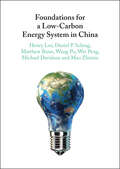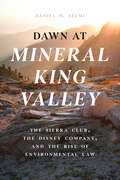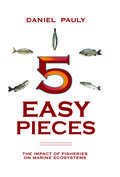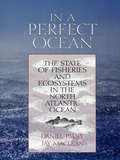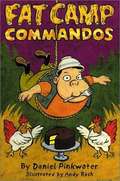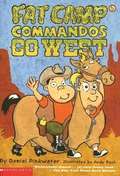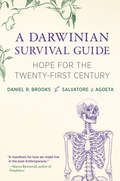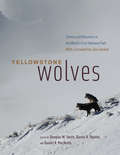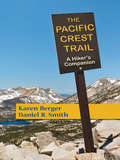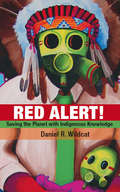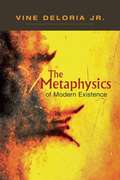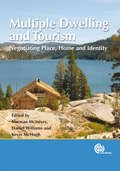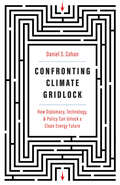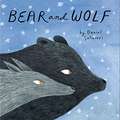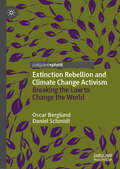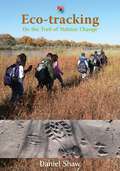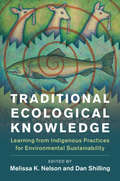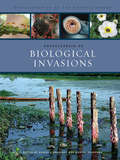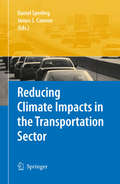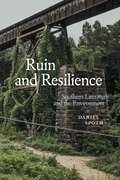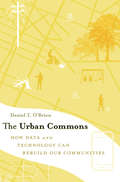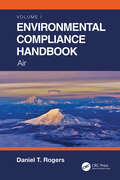- Table View
- List View
Foundations for a Low-Carbon Energy System in China
by Michael Davidson Henry Lee Matthew Bunn Wei Peng Daniel P. Schrag Wang Pu Mao ZhiminClimate change is a key problem of the 21st century. China, as the largest emitter of greenhouse gases, has committed to stabilize its current emissions and dramatically increase the share of electricity production from non-fossil fuels by 2030. However, this is only a first step: in the longer term, China needs to aggressively strive to reach a goal of zero-emissions. Through detailed discussions of electricity pricing, electric vehicle policies, nuclear energy policies, and renewable energy policies, this book reviews how near-term climate and energy policies can affect long-term decarbonization pathways beyond 2030, building the foundations for decarbonization in advance of its realization. Focusing primarily on the electricity sector in China - the main battleground for decarbonization over the next century – it provides a valuable resource for researchers and policymakers, as well as energy and climate experts.
Dawn at Mineral King Valley: The Sierra Club, the Disney Company, and the Rise of Environmental Law
by Daniel P. SelmiThe story behind the historic Mineral King Valley case, which reveals how the Sierra Club battled Disney’s ski resort development and launched a new environmental era in America. In our current age of climate change–induced panic, it’s hard to imagine a time when private groups were not actively enforcing environmental protection laws in the courts. It wasn’t until 1972, however, that a David and Goliath–esque Supreme Court showdown involving the Sierra Club and Disney set a revolutionary legal precedent for the era of environmental activism we live in today. Set against the backdrop of the environmental movement that swept the country in the late 1960s and early 1970s, Dawn at Mineral King Valley tells the surprising story of how the US Forest Service, the Disney company, and the Sierra Club each struggled to adapt to the new, rapidly changing political landscape of environmental consciousness in postwar America. Proposed in 1965 and approved by the federal government in 1969, Disney’s vast development plan would have irreversibly altered the practically untouched Mineral King Valley, a magnificently beautiful alpine area in the Sierra Nevada mountains. At first, the plan met with unanimous approval from elected officials, government administrators, and the press—it seemed inevitable that this expanse of wild natural land would be radically changed and turned over to a private corporation. Then the scrappy Sierra Club forcefully pushed back with a lawsuit that ultimately propelled the modern environmental era by allowing interest groups to bring litigation against environmentally destructive projects. An expert on environmental law and appellate advocacy, Daniel P. Selmi uses his authoritative narrative voice to recount the complete history of this revolutionary legal battle and the ramifications that continue today, almost 50 years later.
5 Easy Pieces: The Impact of Fisheries on Marine Ecosystems
by Daniel Pauly5Easy Pieces features five contributions, originally published in Nature and Science, demonstrating the massive impacts of modern industrial fisheries on marine ecosystems. Initially published over an eight-year period, from 1995 to 2003, these articles illustrate a transition in scientific thought--from the initially-contested realization that the crisis of fisheries and their underlying ocean ecosystems was, in fact, global to its broad acceptance by mainstream scientific and public opinion. Daniel Pauly, a well-known fisheries expert who was a co-author of all five articles, presents each original article here and surrounds it with a rich array of contemporary comments, many of which led Pauly and his colleagues to further study. In addition, Pauly documents how popular media reported on the articles and their findings. By doing so, he demonstrates how science evolves. In one chapter, for example, the popular media pick up a contribution and use Pauly's conclusions to contextualize current political disputes; in another, what might be seen as nitpicking by fellow scientists leads Pauly and his colleagues to strengthen their case that commercial fishing is endangering the global marine ecosystem. This structure also allows readers to see how scientists' interactions with the popular media can shape the reception of their own, sometimes controversial, scientific studies. In an epilog, Pauly reflects on the ways that scientific consensus emerges from discussions both within and outside the scientific community.
In a Perfect Ocean: The State Of Fisheries And Ecosystems In The North Atlantic Ocean (The State of the World's Oceans #1)
by Jay Maclean Daniel PaulyRecent decades have been marked by the decline or collapse of one fishery after another around the world, from swordfish in the North Atlantic to orange roughy in the South Pacific. While the effects of a collapse on local economies and fishing-dependent communities have generated much discussion, little attention has been paid to its impacts on the overall health of the ocean's ecosystems.In a Perfect Ocean: The State of Fisheries and Ecosystems in the North Atlantic Ocean presents the first empirical assessment of the status of ecosystems in the North Atlantic ocean. Drawing on a wide range of studies including original research conducted for this volume, the authors analyze 14 large marine ecosystems to provide an indisputable picture of an ocean whose ecology has been dramatically altered, resulting in a phenomenon described by the authors as "fishing down the food web." The book provides a snapshot of the past health of the North Atlantic and compares it to its present status; presents a rigorous scientific assessment based on key criteria; considers the factors that have led to the current situation; describes the policy options available for halting the decline; and offers recommendations for restoring the North Atlantic. This is the first in a series of assessments by the world's leading marine scientists, entitled "The State of the World's Oceans." In a Perfect Ocean: The State of Fisheries and Ecosystems in the North Atlantic Ocean is a landmark study, the first of its kind to make a comprehensive, ecosystem-based assessment of the North Atlantic Ocean, and will be essential reading for policymakers at the state, national, and international level concerned with fisheries management, as well for scientists, researchers, and activists concerned with marine issues or fishing and the fisheries industry.
Fat Camp Commandos
by Daniel PinkwaterKids of all sizes think about being fat or thin or in between. This book is about kids sent to camp to lose weight. Could you go to a camp where the sugarless syrup on the one pancake you get tastes like mouthwash? The camp is in Mountainburg. Home of fortune-telling chickens, the infamous Tator Family, and Camp Noo Yoo. Yes, Camp Noo Yoo, where frantic parents send their pudgy little darlings in hopes that a diet of shredded carrots with raisins will turn them into pre-adolescent fashion plates. Or at least help them shed a few of those socially unacceptable extra pounds. Fed up with the jeering and abuse at Camp Noo Yoo, Ralph and Sylvia Nebula and their new friend, Mavis Goldfarb, hop a bus back home to Pokooksie. There, they seek revenge. Revenge on their parents. Revenge on Dr. Frizzbender, founder of Anti-Fat Day. And revenge on Richard "Dick" Tator, the overweight and overbearing owner of Camp Noo Yoo. Enter the world of Pinkwater, where size is not an obstacle, but a source of strength, and where your favorite poison, be it a Twinkie, a Krispy Kreme doughnut, or a banana split, is always at arms reach. This book may have the shortest chapters in history. There are 62 chapters in 89 pages. Chapter 15 is only 10 words long. Chapter 55 is so short that it's completely missing. Read this book with someone you love--and treat yourself to cookies and milk while you're at it.
Fat Camp Commandos Go West
by Daniel PinkwaterSaddle up, cowpokes, and get ready for the Wild, Wild West! Ralph, Sylvia, and Mavis, the pudgy pranksters from FAT CAMP COMMANDOS, are back -- and this time they are out to shake up the sleepy Western town of Horny Toad.
A Darwinian Survival Guide: Hope for the Twenty-First Century
by Daniel R. Brooks Salvatore J. AgostaHow humanity brought about the climate crisis by departing from its evolutionary trajectory 15,000 years ago—and how we can use evolutionary principles to save ourselves from the worst outcomes.Despite efforts to sustain civilization, humanity faces existential threats from overpopulation, globalized trade and travel, urbanization, and global climate change. In A Darwinian Survival Guide, Daniel Brooks and Salvatore Agosta offer a novel—and hopeful—perspective on how to meet these tremendous challenges by changing the discourse from sustainability to survival. Darwinian evolution, the world&’s only theory of survival, is the means by which the biosphere has persisted and renewed itself following past environmental perturbations, and it has never failed, they explain. Even in the aftermath of mass extinctions, enough survivors remain with the potential to produce a new diversified biosphere.Drawing on their expertise as field biologists, Brooks and Agosta trace the evolutionary path from the early days of humans through the Late Pleistocene and the beginning of the Anthropocene all the way to the Great Acceleration of technological humanity around 1950, demonstrating how our creative capacities have allowed humanity to survive. However, constant conflict without resolution has made the Anthropocene not only unsustainable, but unsurvivable. Guided by the four laws of biotics, the authors explain how humanity should interact with the rest of the biosphere and with each other in accordance with Darwinian principles. They reveal a middle ground between apocalypse and utopia, with two options: alter our behavior now at great expense and extend civilization or fail to act and rebuild in accordance with those same principles. If we take the latter, then our immediate goal ought to focus on preserving as many of humanity&’s positive achievements—from high technology to high art—as possible to shorten the time needed to rebuild.
Yellowstone Wolves: Science and Discovery in the World's First National Park (America's Animal Comebacks Ser.)
by Douglas W. Smith Daniel R. MacNulty Daniel R. StahlerIn 2020, it will have been twenty-five years since one of the greatest wildlife conservation and restoration achievements of the twentieth century took place: the reintroduction of wolves to the world’s first national park, Yellowstone. Eradicated after the park was established, then absent for seventy years, these iconic carnivores returned to Yellowstone in 1995 when the US government reversed its century-old policy of extermination and—despite some political and cultural opposition—began the reintroduction of forty-one wild wolves from Canada and northwest Montana. In the intervening decades, scientists have studied their myriad behaviors, from predation to mating to wolf pup play, building a one-of-a-kind field study that has both allowed us to witness how the arrival of top predators can change an entire ecosystem and provided a critical window into impacts on prey, pack composition, and much else. Here, for the first time in a single book, is the incredible story of the wolves’ return to Yellowstone National Park as told by the very people responsible for their reintroduction, study, and management. Anchored in what we have learned from Yellowstone, highlighting the unique blend of research techniques that have given us this knowledge, and addressing the major issues that wolves still face today, this book is as wide-ranging and awe-inspiring as the Yellowstone restoration effort itself. We learn about individual wolves, population dynamics, wolf-prey relationships, genetics, disease, management and policy, newly studied behaviors and interactions with other species, and the rippling ecosystem effects wolves have had on Yellowstone’s wild and rare landscape. Perhaps most importantly of all, the book also offers solutions to ongoing controversies and debates. Featuring a foreword by Jane Goodall, beautiful images, a companion online documentary by celebrated filmmaker Bob Landis, and contributions from more than seventy wolf and wildlife conservation luminaries from Yellowstone and around the world, Yellowstone Wolves is a gripping, accessible celebration of the extraordinary Yellowstone Wolf Project—and of the park through which these majestic and important creatures once again roam.
The Pacific Crest Trail: A Hiker's Companion (Second Edition)
by Karen Berger Daniel R. SmithThis book begins where basic trail guides and maps leave off. For each section of the trail, the authors describe the route in detail and recommend the best day hikes and short backpacks from each trailhead. They describe the plants and animals hikers will see, tell stories about local history, explain plate tectonics, and in a thousand other ways enrich your experience of the journey. For many people, the Pacific Crest Trail is the ultimate long-distance hiking trail. Beginning in the dry valleys of southern California, it follows the crest of the snow-capped Sierras and ends in the ancient forests of Washington's Cascades. Along the way, national treasures such as Yosemite, Crater Lake, and Mount Rainier make this trail one of the premier hiking destinations in the world. But hiking is about much more than getting from A to B. Berger and Smith draw on their tremendous experience--together they have logged more than 12,000 miles on the PCT--to give tested advice to long-distance hikers on trip planning, gear and safety, seasonal considerations, trailheads and resupplies, permits, and much more.
Red Alert!
by Daniel R. Wildcat"Red Alert! offers insight, hope, and a path forward."--Billy Frank Jr., Chairman, Northwest Indian Fisheries Commission"What the world needs today is a good dose of indigenous realism," says Native American scholar Daniel R. Wildcat in this thoughtful, forward-looking treatise. The Native response to the environmental crisis facing our planet, Red Alert! seeks to debunk our civilization's long-misguided perception that humankind is at odds with nature or that it exerts control over the natural world.Taking a hard look at the biggest problem that we face today--the damaging way we live on this earth--Wildcat draws upon ancient Native American wisdom and nature-centered beliefs to advocate a modern strategy to combat global warming. Inspiring and insightful, Red Alert! is a stirring call to action.Daniel R. Wildcat (Yuchi, Muscogee) is the director of the American Indian studies program and the Haskell Environmental Research Studies Center at Haskell Indian Nations University in Lawrence, Kansas. He is the co-author with Vine Deloria Jr. of Power and Place: Indian Education in America and the co-author of Destroying Dogma: Vine Deloria Jr. and His Influence on American Society.
The Metaphysics of Modern Existence
by David E. Wilkins Vine Deloria Jr. Daniel R. WildcatVine Deloria Jr., named one of the most influential religious thinkers in the world by Time, shares a framework for a new vision of reality. Bridging science and religion to form an integrated idea of the world, while recognizing the importance of tribal wisdom, The Metaphysics of Modern Existence delivers a revolutionary view of our future and our world. David E. Wilkins holds the McKnight Presidential Professorship in American Indian Studies at the University of Minnesota. Daniel R. Wildcat is the director of the American Indian studies program and the Haskell Environmental Research Studies Center at Haskell Indian Nations University.
Multiple Dwelling and Tourism: Negotiating Place, Home and Identity
by Norman Mcintyre Daniel R. Williams Kevin E. MchughThe movement of people, goods, capital and information is a central aspect of living in the inter-connected, globalised late-modern world. Although this broader view of mobility is recognized, this book focuses mainly on migration or the movement of people and examines multiple dwelling as a societal response to the major influences of increased mobility and amenity tourism.
Confronting Climate Gridlock: How Diplomacy, Technology, and Policy Can Unlock a Clean Energy Future
by Daniel S CohanAn atmospheric scientist explains why global climate change mitigation and energy decarbonization demand American diplomacy, technology, and policy &“Daniel Cohan makes a compelling case that the problem of climate change is solvable. Fixing the gridlock on global action requires fixing the gridlock here in the United States of America. Cohan shows how that can be done.&”—David Victor, UC San Diego Professor of environmental engineering Daniel Cohan argues that escaping the gravest perils of climate change will first require American diplomacy, technological innovation, and policy to catalyze decarbonization globally. Combining his own expertise along with insights from more than a hundred interviews with diplomats, scholars, and clean-technology pioneers, Cohan identifies flaws in previous efforts to combat climate change. He highlights opportunities for more successful strategies, including international &“climate clubs&” and accelerated development of clean energy technologies. Grounded in history and emerging scholarship, this book offers a forward-looking vision of solutions to confronting climate gridlock and a clear-eyed recognition of the challenges to enacting them.
Managing Land Use Conflicts: Case Studies in Special Area Management
by David J. Brower Daniel S. CarolThis work contains a series of case studies of the planning phenomenon that has become known as Special Area Management (SAM)--those areas so naturally valuable, so important for human use, so sensitive to impact, or so particular in their planning requirements as to need special management treatment. Based on an examination of the SAMs, this work integrates various aspects of the process of their planning and management and proposes policy and administrative guidelines to improve SAMs as a planning tool.
Bear and Wolf
by Daniel SalmieriBear and Wolf become unlikely companions one winter's evening when they discover each other out walking in the falling snow. <P><P> They're young and curious, slipping easily into friendship as they amble along together, seeing new details in the snowy forest. Together they spy an owl overhead, look deep into the frozen face of the lake, and contemplate the fish sleeping below the surface. Then it's time to say goodbye: for Bear to go home and hibernate with the family and for Wolf to run with the pack. Daniel Salmieri's debut as author/illustrator is a beautifully rendered story of friendship and the subtle rhythm of life when we are open to the world and to each other.
Extinction Rebellion and Climate Change Activism: Breaking the Law to Change the World
by Daniel Schmidt Oscar BerglundThis book summarises and critiques Extinction Rebellion (XR) as a social movement organisation, engaging with key issues surrounding its analysis, strategy and tactics. The authors suggest that XR have an underdeveloped and apolitical view of the kind of change necessary to address climate change, and that while this enables the building of broad movements, it is also an obstacle to achieving the systemic change that they are aiming for. The book analyses different forms of protest and the role of civil disobedience in their respective success or failure; democratic demands and practices; and activist engagement with the political economy of climate change. It engages with a range of theoretical perspectives that address law-breaking in protest and participatory forms of democracy including liberal political theory; anarchism and forms of historical materialism, and will be of interest to students and scholars across politics, international relations, sociology, policy studies and geography, as well as those interested in climate change politics and activism.
Eco-tracking: On the Trail of Habitat Change (Barbara Guth Worlds of Wonder Science Series for Young Readers)
by Daniel ShawIn this much-needed work for our nation's youth, Daniel Shaw tracks the interconnections of small regional ecosystems to larger ones, and in the process demonstrates the accessibility of nature to everyone. As Shaw notes in his introduction, the story that is too often told about the environment is one about despair and destruction, which basically suggests to young people that all is lost and everything was better before their time. Instead, this book tells true life success stories of young people involved in citizen science efforts and how others can join in tracking climate change, local wildlife, and other parts of the natural world. Shaw's work demonstrates by example a story of hope for a natural environment that exists in the world. At the core of this book is the notion that humans are components of their ecosystems. Shaw encourages readers to learn what becomes of their outputs and to understand human contributions to various ecological cycles. Sidebars and activities give readers a chance to discover these cycles right in their backyards and to link their discoveries to neighborhood environments.
Southwest Aquatic Habitats: On the Trail of Fish in a Desert (Barbara Guth Worlds of Wonder Science Series for Young Readers)
by Daniel ShawYou might not expect to find a fish in the desert, but if you look, find them you will. In this book a nationally honored science teacher tells true stories about real young people who study and care for water, fish, and other creatures in and around desert streams, ponds, lakes, and rivers. The book starts out with Katie&’s story as she fishes for trout in a mountain stream. The stories then twist across large dry areas where water is sparse. They include urban adventures like Andres and his friends testing river water in the middle of a city to see if it is fit for human use. Other stories stretch back in time like the one about Kamella&’s family using river water to raise fruits and vegetables as they have done for over eight hundred years as members of the Ohkay Owingeh Pueblo. As the desert rivers reach their oceans, the stories wash out to sea.
Warmth: Coming of Age at the End of Our World
by Daniel SherrellFrom a millennial climate activist, an exploration of how young people live in the shadow of catastrophe&“Strikingly perceptive.&” —Jenny Offill, author of Weather &“Beautifully rendered and bracingly honest.&” —Jenny Odell, author of How to Do NothingWarmth is a new kind of book about climate change: not what it is or how we solve it, but how it feels to imagine a future--and a family--under its weight. In a fiercely personal account written from inside the climate movement, Sherrell lays bare how the crisis is transforming our relationships to time, to hope, and to each other. At once a memoir, a love letter, and an electric work of criticism, Warmth goes to the heart of the defining question of our time: how do we go on in a world that may not?
Traditional Ecological Knowledge: Learning from Indigenous Practices for Environmental Sustainability (New Directions in Sustainability and Society)
by Melissa K. Nelson Daniel ShillingThis book examines the importance of Traditional Ecological Knowledge (TEK) and how it can provide models for a time-tested form of sustainability needed in the world today. The essays, written by a team of scholars from diverse disciplinary backgrounds, explore TEK through compelling cases of environmental sustainability from multiple tribal and geographic locations in North America and beyond. Addressing the philosophical issues concerning indigenous and ecological knowledge production and maintenance, they focus on how environmental values and ethics are applied to the uses of land. Grounded in an understanding of the profound relationship between biological and cultural diversity, this book defines, interrogates, and problematizes, the many definitions of traditional ecological knowledge and sustainability. It includes a holistic and broad disciplinary approach to sustainability, including language, art, and ceremony, as critical ways to maintain healthy human-environment relations.
Encyclopedia of Biological Invasions
by Daniel Simberloff Marcel RejmanekThis pioneering encyclopedia illuminates a topic at the forefront of global ecology--biological invasions, or organisms that come to live in the wrong place. Written by leading scientists from around the world, Encyclopedia of Biological Invasions addresses all aspects of this subject at a global level--including invasions by animals, plants, fungi, and bacteria--in succinct, alphabetically arranged articles. Scientifically uncompromising, yet clearly written and free of jargon, the volume encompasses fields of study including biology, demography, geography, ecology, evolution, sociology, and natural history. Featuring many cross-references, suggestions for further reading, illustrations, an appendix of the world's worst 100 invasive species, a glossary, and more, this is an essential reference for anyone who needs up-to-date information on this important topic. Encyclopedia of Biological Invasions features articles on: * Well-known invasive species such the zebra mussel, chestnut blight, cheatgrass, gypsy moth, Nile perch, giant African snail, and Norway rat * Regions with especially large numbers of introduced species including the Great Lakes, Mediterranean Sea, Hawaiian Islands, Australia, and New Zealand. * Conservation, ecological, economic, and human and animal health impacts of invasions around the world * The processes and pathways involved in invasion * Management of introduced species
Reducing Climate Impacts in the Transportation Sector
by James S. Cannon Daniel SperlingMore than 250 experts from around the world gathered at the Asilomar Transportation and Energy Conference in August 2007 to tackle what many agree is the greatest environmental challenge the world faces: climate change. This 11th Biennial Conference, organized under the auspices of the Energy and Alternative Fuels Committees of the U.S. Transportation Research Board, examined key climate change policy issues and strategies to combat climate impacts from the transportation sector, a leading source of greenhouse gas emissions. This book includes chapters by leading presenters at the Asilomar Conference that reflect the most current views of the world's experts about a critical and rapidly evolving energy and environmental problem. The chapters in this book examine increasing worldwide emissions of greenhouse gases, uncertain oil supply, evolving climate change science, public attitudes toward climate change, and the implications for the U.S. of growth in China, India and elsewhere. They propose methods to reduce growth in vehicle travel through alternative fuel, new technologies, and land use planning. They examine the costs and the potential for greenhouse gas reduction through deployment of advanced technology and alternative fuels and propose strategies to motivate consumers to buy fuel efficient and alternative fuel vehicles, including heavy duty trucks.
Ruin and Resilience: Southern Literature and the Environment (Southern Literary Studies)
by Daniel SpothIn Ruin and Resilience, Daniel Spoth confronts why the environmental stories told about the U.S. South curve inevitably toward distressing plotlines. Examining more than a dozen works of postbellum literature and cinema, Spoth’s analysis winds from John Muir’s walking journey across the war-torn South, through the troubling of southern environmentalism’s modernity by Faulkner and Hurston, past the accounts of its acceleration in Welty and O’Connor, and finally into the present, uncovering how the tragic econarrative is transformed by contemporary food studies, climate fiction, and speculative tales inspired by the region. Phrased as a reaction to the rising temperatures and swelling sea levels in the South, Ruin and Resilience conceptualizes an environmental, ecocritical ethos for the southern United States that takes account of its fundamentally vulnerable status and navigates the space between its reactionary politics and its ecological failures.
The Urban Commons: How Data and Technology Can Rebuild Our Communities
by Daniel T. O'BrienThrough voicemail, apps, websites, and Twitter, Boston’s sophisticated 311 system allows citizens to report potholes, broken streetlights, graffiti, and vandalism that affect everyone’s quality of life. Drawing on Boston’s rich data, Daniel T. O’Brien offers a model of what smart technology can do for cities seeking both growth and sustainability.
Environmental Compliance Handbook, Volume 1: Air
by Daniel T. RogersEnvironmental laws and regulations are extremely complex and difficult to understand. In order to comply with them, they need to be explained in layperson’s terms. This handbook identifies many changes in regulations and recommends ways to apply and implement them. Containing the latest environmental information, this volume addresses environmental compliance with air and provides a historical perspective to help follow the logical growth and increased complexity of air regulations through time. Structured as a “step-by-step how-to” book, readers will find real-life examples for the most important aspects of language, permit terms, demonstrating compliance, and organization for air projects. Features: Identifies all air pollution control regulations and the requirements of any air pollution control permits available up to date. Answers in depth all practical questions that arise when working on compliance projects in a “how to” method. Addresses a wider spectrum of issues that go beyond chemical-based contamination and environmental regulations and examines the impacts of climate change Includes many real-life examples from industry and institutions that comply with air quality regulations and air pollution control permits It is global in coverage and very useful to companies that have expanded operations outside their country of origin.
